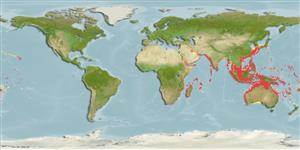>
Elopiformes (Tarpons and tenpounders) >
Elopidae (Tenpounders)
Etymology: Elops: Greek, ellops = a kind of serpent (Ref. 45335).
Environment: milieu / climate zone / depth range / distribution range
Écologie
marin; saumâtre; océanodrome. Tropical; 38°N - 37°S, 22°E - 153°W
Indo-Pacific: Mossel Bay in South Africa, to the Red Sea and India, possibly to western Pacific (Ref. 3968).
Taille / Poids / Âge
Maturity: Lm ? range ? - ? cm
Max length : 118 cm FL mâle / non sexé; (Ref. 40637); common length : 50.0 cm SL mâle / non sexé; (Ref. 4967); poids max. publié: 10.8 kg (Ref. 40637)
Épines dorsales (Total): 0; Rayons mous dorsaux (Total): 20-27; Épines anales 0; Rayons mous anaux: 14 - 18.
Occurs in coastal waters, but enters lagoons and estuaries (Ref. 4832) [actual freshwater records remain to be confirmed]. Benthopelagic (Ref. 58302). Young and adults feed on small fishes and crustaceans (Ref. 5213). Probably spawn at sea, but the transparent larvae migrate to inshore areas and are often found in brackish water (Ref. 7050). Are voracious carnivores that take fish, squid and shrimp bait (Ref. 3968). Edible, but not tasty and full of bones (Ref. 3968). A total length of 126 cm for this species has been reported from Knysna, South Africa (G. Bernardt, pers. comm., e-mail: gerard@smallstreams.com) .
Life cycle and mating behavior
Maturité | Reproduction | Frai | Œufs | Fécondité | Larves
Smith, M.M., 1986. Elopidae. p. 155-156. In M.M. Smith and P.C. Heemstra (eds.) Smiths' sea fishes. Springer-Verlag, Berlin. (Ref. 3968)
Statut dans la liste rouge de l'IUCN (Ref. 130435)
Menace pour l'homme
Harmless
Utilisations par l'homme
Pêcheries: commercial; pêche sportive: oui
Plus d'informations
RéférencesAquacultureProfil d'aquacultureSouchesGénétiqueElectrophoresesHéritabilitéPathologiesTraitementNutrientsMass conversion
Outils
Articles particuliers
Télécharger en XML
Sources Internet
Estimates based on models
Preferred temperature (Ref.
123201): 20.7 - 28.4, mean 26.9 °C (based on 1366 cells).
Phylogenetic diversity index (Ref.
82804): PD
50 = 0.5176 [Uniqueness, from 0.5 = low to 2.0 = high].
Bayesian length-weight: a=0.00676 (0.00514 - 0.00889), b=2.99 (2.91 - 3.07), in cm total length, based on LWR estimates for this species (Ref.
93245).
Niveau trophique (Ref.
69278): 4.0 ±0.3 se; based on diet studies.
Generation time: 2.3 ( na - na) years. Estimated as median ln(3)/K based on 1
growth studies.
Résilience (Ref.
120179): Haut, temps minimum de doublement de population inférieur à 15 mois (Preliminary K or Fecundity.).
Fishing Vulnerability (Ref.
59153): Moderate vulnerability (40 of 100).
